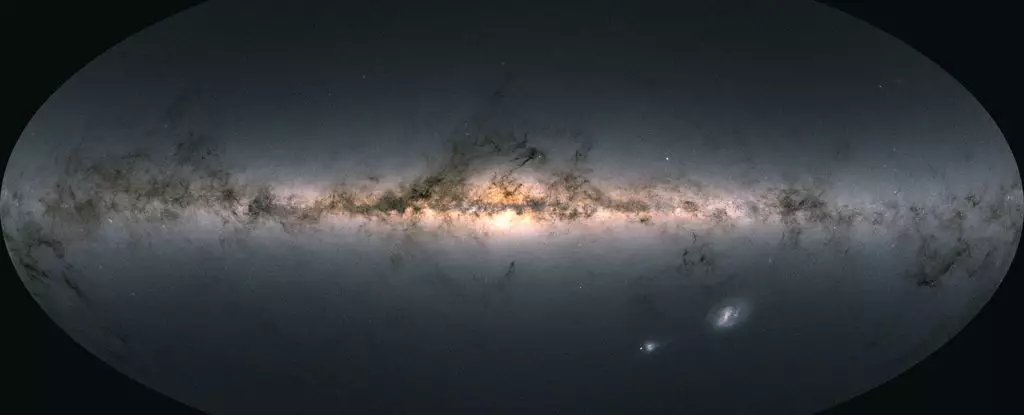The concept of galaxies colliding is often depicted in science fiction, but it’s a rather ordinary process in the universe. It appears that the Milky Way may be on a collision course with not just another galaxy, but a supermassive black hole nestled within the Large Magellanic Cloud (LMC). Research led by astrophysicist Jiwon Jesse Han from the Harvard & Smithsonian Center for Astrophysics suggests that hidden within the LMC could be a colossal and elusive black hole, one weighing approximately 600,000 times the mass of our Sun.
Understanding the Celestial Dance of the Milky Way and Large Magellanic Cloud
The Large Magellanic Cloud, a dwarf galaxy orbiting the Milky Way, is on a spiral path that will inevitably lead it to our galactic home. Estimates indicate that this cosmic encounter will occur in about 2 billion years. However, the significance of this event transcends mere collision; it may signify a rendezvous with a black hole that has remained undetected thus far. Based on their latest findings, Han and his research team emphasize how this hidden black hole could serve as a pivotal piece in understanding the evolution of supermassive black holes from smaller progenitors, a transition that remains poorly understood in contemporary astrophysics.
The existence of the proposed 600,000-solar-mass black hole falls into a mass category that is not frequently observed. Most black holes are either stellar-sized or supermassive, with masses that typically exceed millions of solar masses. Discovering a black hole occupying this intermediate mass range would provide invaluable insights into how these cosmic titans grow and evolve over time, potentially through hierarchical merging processes during galactic encounters.
Detecting a black hole is no trivial task, given their insatiable appetite for matter and their inability to emit light on their own. A black hole is typically only observable when it is engaged in an active accretion process, which creates electromagnetic radiation as matter spirals into its maw. Without this luminous signature, researchers must employ indirect methods to infer a black hole’s presence. Primarily, they analyze the movements and velocities of stars in the vicinity.
The study of stellar dynamics has led to significant breakthroughs in confirming the existence of various black holes. For instance, the mass and presence of Sagittarius A*, the Milky Way’s supermassive black hole, were confirmed through careful observation of star orbits. However, Han’s study diverges from this classical method. The researchers directed their focus toward hypervelocity stars—unusually fast-moving stars that almost seem to defy the gravitational grip of their host galaxy.
Central to the analysis presented by Han’s team is the Hills mechanism, a theoretical framework describing how a black hole can interact with a binary star system, resulting in one of the stars being flung into space at incredible velocities. The gravitational tug-of-war allows astrophysicists to trace the origins of these hypervelocity stars, essentially linking their accelerated movements back to a potential black hole.
Armed with data from the retired Gaia space mission, which meticulously charted various celestial objects and their three-dimensional motion, Han’s team focused on 21 stars that displayed hypervelocity behavior consistent with the Hills mechanism. Through rigorous analysis, they successfully traced 16 of these stars to their points of origin, leading to a captivating potential revelation: the presence of this 600,000-solar-mass black hole residing in the LMC.
What does it mean for the Milky Way to collide with an LMC black hole? This event would not only be a spectacle of cosmic proportions but also a unique opportunity to understand black hole growth. As the two galaxies merge, the black hole from the LMC could journey to the Milky Way’s core, where it might ultimately merge with Sagittarius A*, contributing to the growth of an even larger supermassive black hole.
The collision would provide astronomers unprecedented conditions to observe the mechanism of black hole growth up close, illustrating a process that, while theorized, has yet to be extensively documented in real-time. Future research aims to confirm the existence of this fascinating black hole and delve deeper into unraveling its properties, propelling our understanding of black holes and their developmental arc within the cosmic landscape.
While cosmic timelines render such future events beyond the reach of human lifetime, the implications and knowledge gleaned from these potential interactions promise to illuminate the enigmatic nature of black holes and their roles in galactic evolution.

Leave a Reply